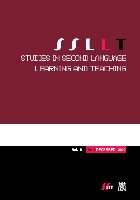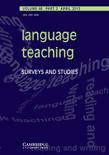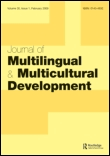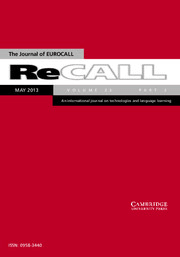
FOREIGN LANGUAGE ANNALS
Scope & Guideline
Shaping the Future of Linguistic Scholarship
Introduction
Aims and Scopes
- Innovative Pedagogical Strategies:
The journal focuses on exploring and evaluating new teaching methodologies that enhance language acquisition, including technology integration, collaborative learning, and content-based instruction. - Cultural and Sociolinguistic Contexts:
Research published in the journal often examines the influence of cultural and sociolinguistic factors on language learning, addressing issues of identity, heritage languages, and the role of cultural representation in the curriculum. - Assessment and Evaluation Practices:
The journal emphasizes the importance of effective assessment methods in language education, including studies on language proficiency assessments, feedback mechanisms, and the impact of various instructional approaches on learner outcomes. - Learner-Centered Research:
A distinctive feature of the journal is its focus on learner perspectives and experiences, investigating motivation, anxiety, and self-regulation in language learning contexts. - Policy and Program Development:
The journal addresses educational policies and programmatic innovations, particularly those related to biliteracy initiatives and language education in diverse educational settings.
Trending and Emerging
- Technology-Enhanced Language Learning:
An increasing number of studies focus on the integration of technology in language learning, examining the effectiveness of online tools, apps, and digital resources in enhancing learner engagement and achievement. - Equity and Social Justice in Language Education:
Emerging discussions around equity and social justice have gained traction, with research exploring how language education can address issues of representation, access, and inclusivity for diverse student populations. - Heritage Language Education:
There is a growing emphasis on heritage language education, investigating the unique needs and motivations of heritage learners and the pedagogical strategies that best support their language development. - Intercultural Competence Development:
Research focused on developing intercultural competence among language learners is trending, highlighting the importance of cultural exchange and understanding in the language learning process. - Reflexivity and Teacher Identity:
Emerging themes around teacher reflexivity and identity in language teaching practices are becoming more prominent, encouraging educators to critically examine their roles and the impact of their backgrounds on their teaching.
Declining or Waning
- Traditional Grammar Instruction:
Research focused on traditional grammar instruction methods appears to be declining, as the field shifts towards more communicative and integrative approaches to language teaching. - General Language Acquisition Theories:
There has been a noticeable decrease in studies solely centered on broad theories of language acquisition, as more researchers emphasize specific contexts, learner experiences, and practical applications in pedagogy. - Static Assessment Models:
The focus on static assessment models that do not account for dynamic learning processes is waning, with a growing preference for formative assessment strategies that foster ongoing learner development. - Research on Monolingual Instruction:
There is a decline in research advocating for monolingual instruction, as the field increasingly recognizes the value of multilingual and multicultural perspectives in language education. - Cognitive Approaches to Language Learning:
Research emphasizing purely cognitive approaches to language learning, without consideration of sociocultural factors, is becoming less prevalent, as the interconnectedness of cognition and culture is more widely acknowledged.
Similar Journals

How-A Colombian Journal for Teachers of English
Unlocking Potential in English Language Acquisition.How: A Colombian Journal for Teachers of English is a prestigious, peer-reviewed publication dedicated to advancing the field of English language teaching in Colombia and beyond. Established by the ASOC COLOMBIANA PROFESORES INGLES, this journal has embraced an Open Access model since 2014, ensuring that innovative research and teaching methodologies are accessible to a global audience. With a focus on pedagogical strategies, curriculum development, and language acquisition, How aims to foster community among educators, researchers, and practitioners dedicated to improving English language instruction. The journal's commitment to high-quality scholarship and practical applications makes it an indispensable resource for professionals seeking to enhance their teaching practices. Housed in Bogotá, Colombia, How reflects the dynamic landscape of English education in Latin America, contributing significantly to both regional and international discourse.

Studies in Second Language Learning and Teaching
Advancing the frontiers of language education.Studies in Second Language Learning and Teaching is a premier open-access journal dedicated to advancing research and scholarship in the fields of education, linguistics, and language acquisition. Published by ADAM MICKIEWICZ UNIVERSITY, KALISZ, this journal has consistently achieved high acclaim, reflected in its impressive Q1 rankings in both Education and Linguistics and Language categories for 2023. With a robust focus on innovative methods, effective pedagogical strategies, and interdisciplinary approaches, Studies in Second Language Learning and Teaching aims to facilitate dialogue among researchers, educators, and practitioners, fostering a deeper understanding of language learning and teaching in diverse contexts. Since its transition to open access in 2011, the journal has expanded its reach, providing valuable resources and research findings to a global audience. With an exceptional Scopus ranking placing it in the top percentiles across multiple categories, this journal stands as a crucial platform for the dissemination of ground-breaking research in second language education.

Language Teaching
Fostering dialogue on the latest trends in language education.Language Teaching, published by Cambridge University Press, is a premier peer-reviewed journal that has been at the forefront of the linguistics and language education field since its inception in 1969. With an impressive impact factor positioning it in the top tier (Q1) of its category, this journal is ranked 22nd among 1,088 in the Arts and Humanities field and maintains an outstanding 98th percentile ranking. Focusing on innovative research and methodologies in language teaching and learning, Language Teaching provides a vital platform for discussing the latest developments in pedagogy, applied linguistics, and curriculum design. Although it does not offer open access options, it reaches a broad audience of researchers, educators, and practitioners dedicated to enhancing language instruction across various contexts. The journal continues to evolve, with plans to cover emerging trends and challenges in language education until 2024, making it an essential resource for anyone invested in the teaching of languages.

JOURNAL OF MULTILINGUAL AND MULTICULTURAL DEVELOPMENT
Celebrating the Richness of Language and DiversityPublished by Routledge Journals, Taylor & Francis Ltd, the JOURNAL OF MULTILINGUAL AND MULTICULTURAL DEVELOPMENT has established itself as a premier platform for scholarly discourse in the fields of cultural studies, linguistics, and education since its inception in 1980. With a significant focus on the multifaceted nature of language and culture, this journal offers invaluable insights that contribute to our understanding of multilingualism and multiculturalism in a globalized world. The journal commands an impressive impact, holding Q1 rankings across three critical categories as of 2023, reflecting its influence within the academic community: 22nd percentile in Cultural Studies, 45th in Linguistics and Language, and 215th in Education. Relevant researchers, professionals, and students are encouraged to engage with groundbreaking research, methodologies, and discussions that highlight the dynamic interconnection of language and culture. To access the journal, please visit Routledge’s dedicated platform, where you can explore a wealth of resources and stay updated on the latest findings up to 2024.

Chuzhdoezikovo Obuchenie-Foreign Language Teaching
Fostering Global Competence through Language LearningIntroducing Chuzhdoezikovo Obuchenie - Foreign Language Teaching, a prominent journal published by NATSIONALNO IZDATELSTVO AZ BUKI, dedicated to the field of foreign language education. With its ISSN 0205-1834 and E-ISSN 1314-8508, this journal aims to provide a comprehensive platform for researchers, educators, and practitioners to share insightful studies, innovative methodologies, and transformative practices in language teaching. The journal is based in Sofia, Bulgaria and is strategically positioned to contribute to the discourse on language acquisition and pedagogy, targeting a global audience interested in enhancing foreign language competencies. Although specific impact factors and H-index data may be unavailable, the journal's commitment to quality and relevance in the field is evident through its rigorous peer-review process, ensuring that published works meet high academic standards. Emphasizing accessibility and inclusivity, Chuzhdoezikovo Obuchenie invites submissions that reflect contemporary challenges and advancements in language education, making it an essential resource for anyone invested in the future of multilingual instruction.

Canadian Journal of Applied Linguistics
Unlocking Insights in Language Acquisition and BeyondCanadian Journal of Applied Linguistics is a premier, peer-reviewed publication dedicated to the field of applied linguistics, encompassing a wide range of topics related to language acquisition, language assessment, teaching methodologies, and sociolinguistics. Published by the ASSOC CANADIENNE LINGUISTIQUE APPLIQUEE, this Open Access journal has been paving the way for innovative research and insightful discourse in the linguistic community since 1998. With its comprehensive insights and scholarly articles, the journal serves as an invaluable resource for researchers, educators, and students alike, facilitating the exchange of ideas and advancements in applied linguistics. The journal is committed to promoting quality research that enhances our understanding of language-related processes in diverse contexts, making it a significant contributor to the global dialogue in linguistics. Based in Ottawa, Canada, the journal is accessible to a wide audience, reflecting its dedication to inclusivity and knowledge sharing in the thriving field of applied linguistics.

LANGUAGE LEARNING & TECHNOLOGY
Innovating Language Learning Through TechnologyLANGUAGE LEARNING & TECHNOLOGY, published by the University of Hawaii's National Foreign Language Resource Center, stands as a pioneering platform within the realms of linguistics, education, and computer science applications. With an impressive impact factor and esteemed rankings—achieving Q1 in Education and Q1 in Linguistics and Language—this open-access journal has been disseminating critical research since its inception in 1997. The journal operates under a commitment to fostering innovative approaches to language learning through technology, making it invaluable for researchers, educators, and practitioners seeking to enhance their understanding of this dynamic intersection. Hailing from the United States, the journal not only promotes scholarly dialogue but also champions accessibility to knowledge, ensuring that the latest advancements in language learning and technology are readily available to a global audience. With converged years documented from 1997 to 1998 and from 2000 to 2021, LANGUAGE LEARNING & TECHNOLOGY continues to play a pivotal role in shaping contemporary discussions around language education and the influence of technology on learning methodologies.

ReCALL
Advancing Research at the Intersection of Language and InnovationReCALL is a prestigious academic journal published by Cambridge University Press, focusing on the rapidly evolving interplay between technology and language learning. Established in 1989, this quarterly journal holds a distinguished Q1 ranking across multiple categories including Computer Science Applications, Education, and Linguistics and Language, reflecting its commitment to the highest standards of scholarly excellence. With an impressive Scopus ranking that places it in the top percentiles across its fields, ReCALL serves as a vital resource for researchers, educators, and professionals interested in the integration of technology in language education. It features cutting-edge research articles, innovative methodological approaches, and comprehensive reviews that offer insights into the current trends and future directions of language learning, teaching, and assessment. By providing a platform for penetrating inquiry and dialogue, ReCALL significantly enhances the discourse surrounding computer-assisted language learning (CALL) and its influence on educational practices worldwide.

English Teaching and Learning
Shaping the Future of English Education through Rigorous ScholarshipEnglish Teaching and Learning is a distinguished academic journal published by SPRINGER SINGAPORE PTE LTD, focusing on the dynamic fields of education and linguistics. With an ISSN of 1023-7267 and an E-ISSN of 2522-8560, this journal serves as a vital platform for researchers, educators, and practitioners interested in advancing the understanding of English language instruction and learning methodologies. Recognized for its high standards, it has achieved a notable Q2 ranking in Education and a prestigious Q1 ranking in Linguistics and Language in 2023, underscoring its impact within these essential scholarly fields. The journal, which spans a converged publication period from 2015 to 2024, endeavors to disseminate innovative research, theoretical insights, and practical applications, making it an invaluable resource for anyone committed to enhancing English education globally. Although it does not operate under an open-access model, its contributions are pivotal in shaping contemporary discourse in English teaching and learning.

Journal of Technology and Chinese Language Teaching
Bridging Technology and Language EducationJournal of Technology and Chinese Language Teaching, published by JOURNAL TECHNOLOGY & CHINESE LANGUAGE TEACHING, serves as an influential platform for scholars and practitioners in the intersecting fields of technology, language education, and linguistic research. With an ISSN of 1949-260X, this journal strives to disseminate cutting-edge research and innovative practices aimed at enhancing the teaching and learning of Chinese language through technological advancements. Operated from the United States, it currently occupies valuable quartiles within its categories, showcasing its significance—ranking Q4 in Computer Science Applications, Q3 in Education, and Q2 in Linguistics and Language. As it spans from 2019 to 2024, the journal provides a rich repository for international contributions, fostering a collaborative environment for educators, researchers, and students alike. With both Scopus and HIndex metrics reflecting a solid reputation, the Journal of Technology and Chinese Language Teaching is pivotal for those keen on pushing the boundaries of language instruction in the digital age.